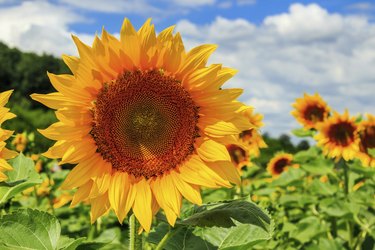
The bright blossoms of sunflowers (Helianthus spp.) are a cheerful addition to any garden. While most home gardeners grow the giant annual sunflowers (Helianthus annuus) for their decorative aspect as well as the tasty seeds, there are also a number of perennial species that grow in U.S. Department of Agriculture plant hardiness zones 3 through 9. To ensure that your sunflowers grow to their full potential, provide the appropriate care through the stages of sunflower growth, from seed to harvest.
Tip
Sunflowers begin as small, hard-shelled seeds which germinate in the garden. The time from germination to mature flowering plants that produce seeds varies, depending on the species and cultivar, but the familiar annuals with giant flower heads complete their life cycle in one season.
Video of the Day
The Sunflower Seed
What we commonly refer to as a sunflower seed, the black-and-white hard-shelled item that you may snack on, is referred to as the achene (fruit). The fruit wall is the shell, and the softer inner piece is the real seed.
Video of the Day
The seed contains more nutrients than its small size might indicate. From fiber and protein, to unsaturated fats, zinc, iron and Vitamin A, Vitamin D, Vitamin E and Vitamin B complex, all can be found in the unassuming sunflower seed.
To start your seed on its path to full-grown sunflower, the seed needs to be planted in a warm, protected location where it will receive full sun all day. It will tolerate many soil types, but prefers a loose, organically-rich and well-drained soil. Keep the soil moist, but not soggy. If the soil dries out, the germinating seed will wither and die.
The Sunflower Sprout
Once the growing conditions have been met and maintained, the seed will germinate and develop into its next stage, the sprout. This stage is short as it quickly matures into a seedling.
Note: Many people soak their sunflower seeds in water just until they sprout. This in itself is an edible food known as "sprouts." Similar to alfalfa sprouts, they are eaten as is, or added to salads, sandwiches and meat dishes. Referred to as a living food, the sunflower sprouts are highly nutritious and have fewer calories than the seeds themselves, while retaining the nutritional value of the dry seed.
The New Seedling
The seedling has a long way to go to be recognized as a sunflower. Started in a full sun location, it will need to be watched carefully so it does not dry out. This may require daily watering, if there is no rain.
As it reaches the young sunflower stage, its stem will become sturdier and thicker. At that point, watering can decrease to every other day or so. Keep the soil evenly moist, but not waterlogged, for optimal growth.
The Young Sunflower
Once the plant reaches a height of 1 to 2 feet, it starts to be recognized as a sunflower. It reaches for the sky growing ever taller, while at the top of the stem one or more buds begin developing. Unless the area is experiencing a drought, at this stage the sunflower can rely on regular rainfall to get its needed moisture.
If you were to watch certain sunflowers during this bud stage, you would see the flowers follow the sun. They start the day facing the east as the sun rises. In a process known as heliotropism, the developing bud will follow the sun from east to west. By morning, it is again facing east, awaiting the sunrise.
The Adult Sunflower
Once the plant begins to bloom, it has reached its adult stage. The bright yellow top of the common sunflower is not a flower, but a head. It is made up of many flowers tightly packed together. Depending on the species and cultivar, the plant may develop one flower head, or multiple stems and flower heads.
The flowers that make up the head are divided into two groups. The outer flowers are called ray florets, while the inner flowers of the circular center are known as disc (disk) florets. These disc florets will mature into what we commonly call the sunflower seed. This part, however, is the fruit and the true seed is found inside.
At this adult stage, the blooming sunflower does not follow the sun's path if it's a heliotropic type. The stem will have stiffened and the majority of sunflowers will face east, each day awaiting the sunrise. Once the seeds fully develop, they must be harvested or protected with netting before the birds swoop in to remove and eat all the seeds.
Sunflower Uses: Flowers and Seeds
All the parts of a sunflower have a further use, beyond the decorative element in the garden. The giant sunflowers make a lovely backdrop against a wall or fence, while the shorter species and cultivars fill borders with a multitude of bright blossoms ranging from white to yellow to burgundy .
When grown as a crop, the leaves and stems of annual sunflowers are used as animal fodder. The yellow flowers are used to make dye, while the seeds can be pressed for their oil , which is comparable to olive or almond oil. The oil sees further uses as a lubricant, and in soaps and paints. In addition, the seeds make a great snack for humans as well as birds and wildlife.